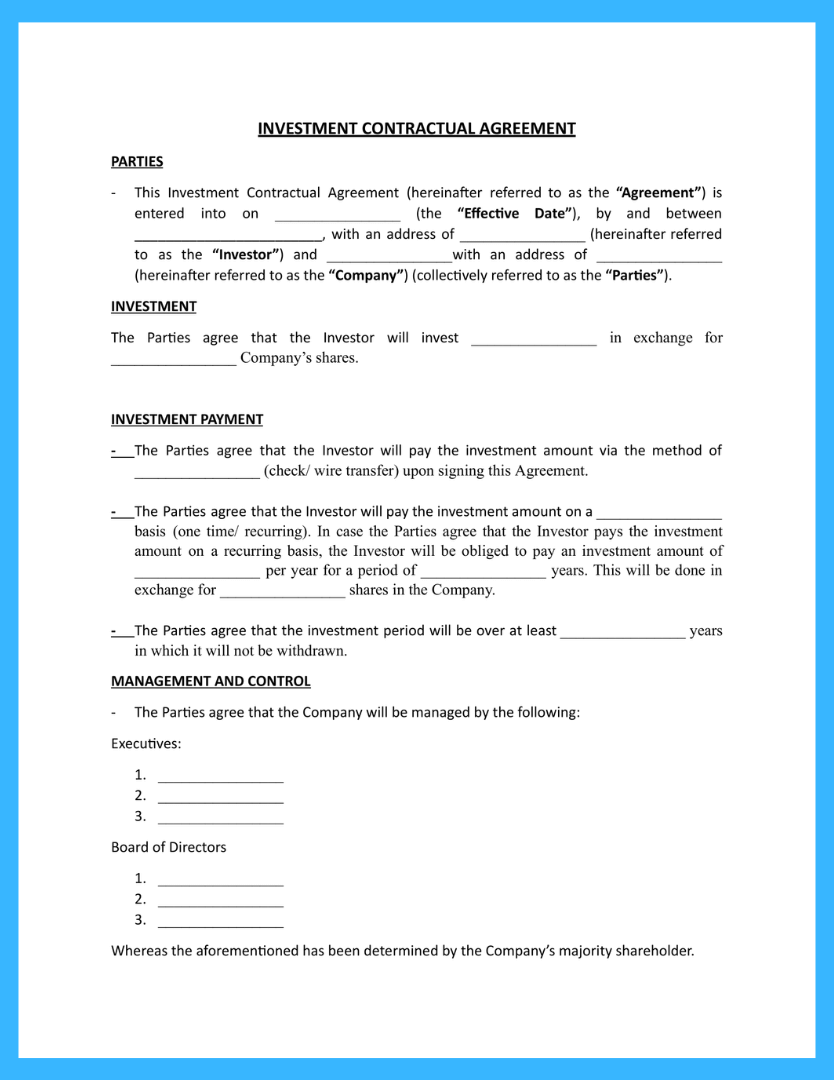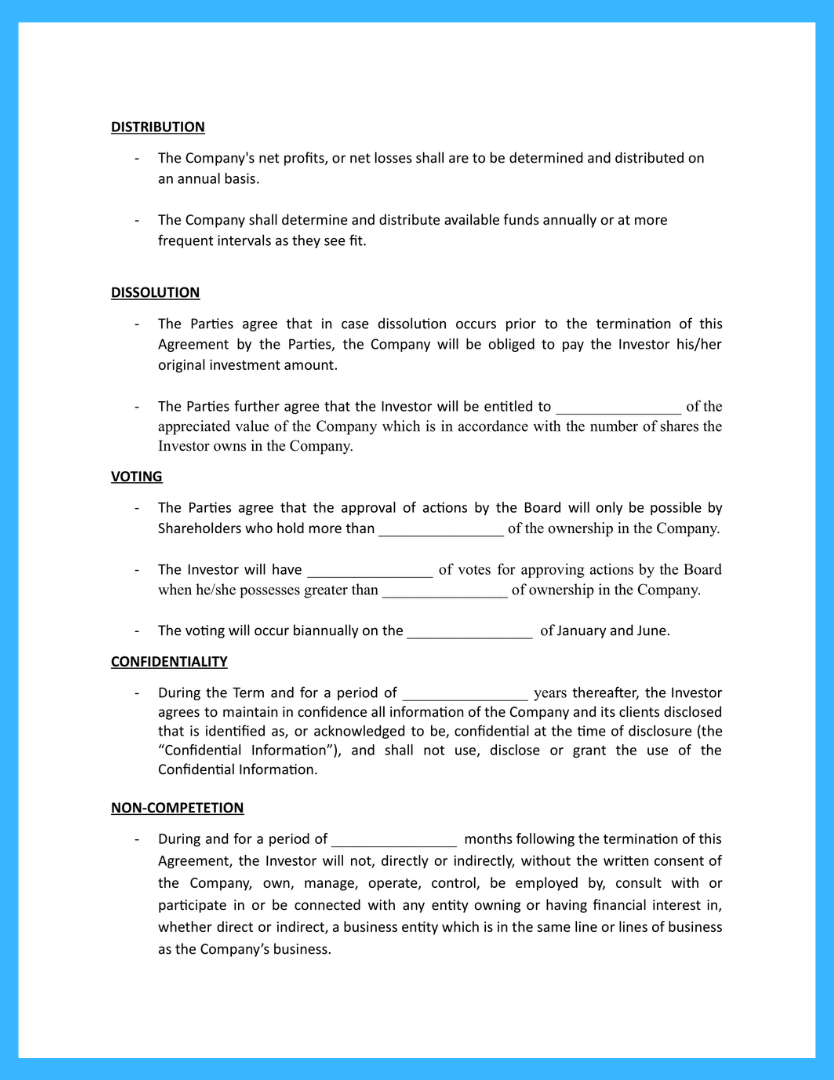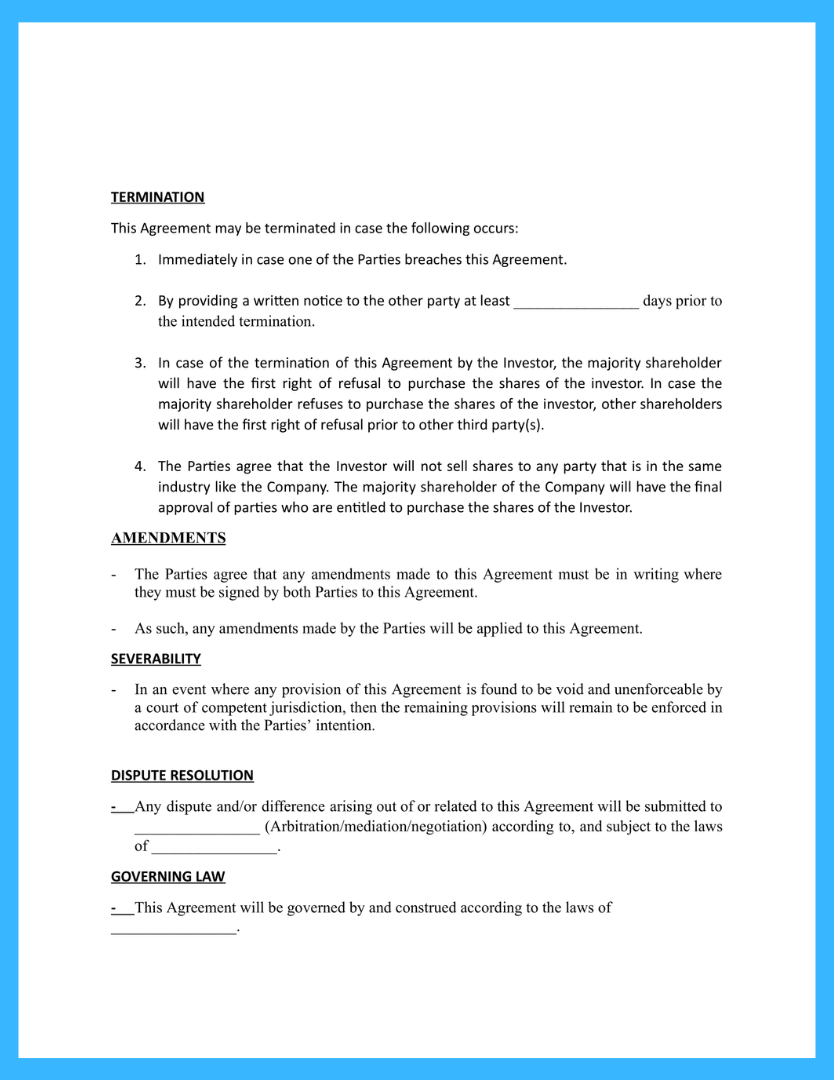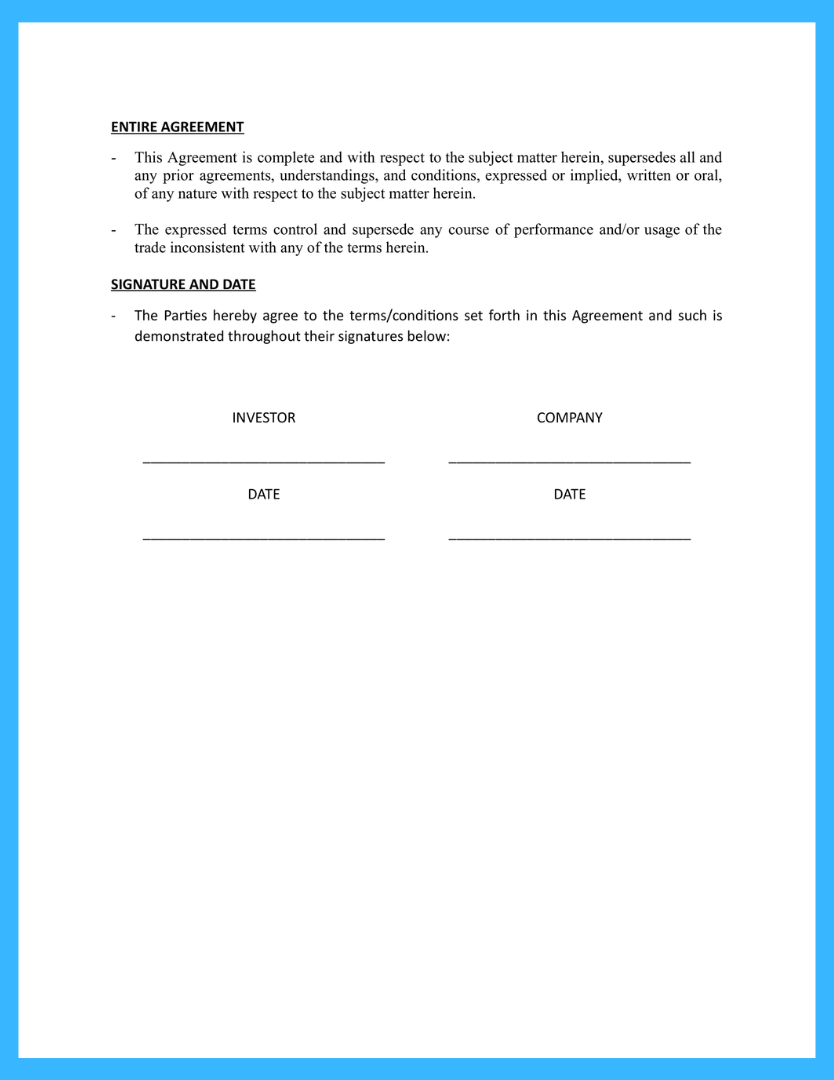Free Investor Agreement Template
We’ve worked with legal experts and proofreaders to create a free investor agreement template. It’ll ensure your interests are prioritized and that your rights and obligations are protected.




What is an Investor Agreement?
An investor agreement is a legal document outlining the terms of an investment between an investor and a company. It can also be referred to as an investment contract, shareholder agreement, term sheet, or stock purchase agreement.
More specifically, an investor agreement covers the following terms:
- How much money the investor is investing
- The type of security the investor is receiving in exchange for their investment
- The investor’s rights and obligations
- The company’s rights and obligations
- The process for selling and transferring the investor’s shares
- The dispute resolution process
These are just some of the terms often found in an investor agreement. Other details may include share purchase price, the number of shares the investor is purchasing, and investor voting rights.
An investor agreement protects both the investor and the company. It’s a legally-binding document that ensures all involved parties understand the terms of the relationship. It informs everyone of the various procedures outlined in the agreement, including a process for resolving disputes.
Why Investor Agreements are Essential for Business
While there’s no universally perfect moment to use an investment proposal, specific scenarios naturally lend themselves to creating this business document.
When starting a new business and securing funding, an investment proposal is a must. It’s also vital when planning to expand current operations, introduce a new product, or explore new markets, and you need financial backing to do so.
If you’re courting prospective investors or attending meetings with financial institutions, a well-crafted investment proposal template can also serve as your comprehensive reference document and effective sales tool.
An investment proposal template can be a lifesaver. It provides a tried-and-tested structure, ensuring that you include all the necessary information in an organized manner, thus helping you build a professional proposal to attract investors to your cause.
DISCLAIMER: We are not lawyers or a law firm and we do not provide legal, business or tax advice. We recommend you consult a lawyer or other appropriate professional before using any templates or agreements from this website.
When to Use an Investor Agreement Template
Drafting up any legal contract is generally a lengthy and complicated process. There are so many terms and conditions to consider, a fine print to mull over. Using a template can shorten this process and save you time, effort, and money.
Templates provide a base structure that can minimize errors and make collaboration easy. You can begin filling it out before getting any lawyers paid by the hour to look it over. Consider using a template if you need an investor agreement.
An investor agreement template should be considered when raising money from investors. It’ll streamline the document preparation, processing, and signing workflows. It will protect both parties—the investor and the company—and provide transparency and improve productivity. Less time is spent preparing, processing, and signing the agreement.
What to Include in an Investor Agreement
An investor agreement template should include several key elements. Six of these are listed below.
Purpose of Investment
The purpose of investment should be one of the first items addressed in the contract, which is why the investor is investing their capital in a company. Some common examples include: making a profit, helping to grow a company, and acquiring control.
There are several reasons why it’s crucial to outline the purpose of investment in the agreement. Some of these include:
- Ensures the investor is aligned with the company’s goals: The purpose of the investment can help ensure that the investor and the company are working toward the same goals. Both parties are on the same page and are aligned concerning their objectives.
- Protects the investor’s interests: The purpose of the investment can help to safeguard the investor’s interests in the event of a dispute. For instance, if the investor is investing to acquire control of the company, they may have more rights than an investor only interested in making a profit.
- Provides clarification and transparency to the company: The purpose of investment can help to clarify the investor’s expectations of the company’s management. This can help to avoid misunderstandings and disputes in the future.
Management and Control
Management and control provisions are important to include in an investor agreement. They define the rights and responsibilities of both parties: the investor and the company’s management. These provisions help avoid any disputes down the road and ensure the company is managed optimally.
Here are some of the key elements that should be included in the management and control provisions of an investor agreement:
- The investor’s rights to participate in management: An investor’s rights to participate in management can depend on the investment size and the investor’s goals. For instance, a controlling investor may have more rights than a profit-seeking investor.
- The company’s management’s obligations to the investor: The company’s management has certain obligations to the investor. Examples include providing information about the company’s operations and informing the investor of any significant changes.
- The process for resolving disputes: The investor agreement should include a fair and impartial dispute resolution process. It should protect the rights of both the investor and the company’s management.
Return on Investment
The return on investment (ROI) provisions of an investor agreement define how the investor will be compensated for their investment. These provisions are important because they protect investors by informing them how they’ll profit from their investments. They also incentivize companies to grow and become successful.
Here are some of the key elements that should be included in the ROI provisions of an investor agreement:
- The type of return: The type of return can be a lump sum payment, an annual dividend, or a share of the company’s profits.
- The timing of the return: The timing of the return can vary depending on the type of return. For example, a lump sum payment may be paid out immediately, while an annual dividend may be paid out once a year.
- The amount of the return: The amount of the return can be based on a set formula, or it can be negotiated between the investor and the company.
- The process for calculating the return: The process for calculating the return should be clear and transparent so that both parties understand how the return will be calculated.
Non Disclosure
A non-disclosure agreement (NDA) is a legally binding contract that prevents the disclosure of confidential information. It can also be referred to as a confidentiality agreement. Regarding investor agreements, NDAs are typically used to protect the company’s trade secrets, financial information, and other sensitive data.
There are several reasons why it’s essential to include a non-disclosure agreement in an investor agreement. Some of these include the following:
- Protects the company’s intellectual property
- Builds trust between the investor and the company
- Helps avoid legal disputes
The non-disclosure agreement should be clear and concise and define the specific information that is being protected. The agreement should also specify the duration of the confidentiality obligation, and it should define the consequences of breaching the agreement.
Here are some of the key elements that should be included in a non-disclosure agreement in an investor agreement:
- The definition of confidential information: The non-disclosure agreement should clearly define what constitutes confidential information. This could include trade secrets, financial information, customer lists, and other sensitive data.
- The scope of the confidentiality obligation: The non-disclosure agreement should specify who is bound by the confidentiality obligation. This could include the investor, the company’s employees, and any other third parties with access to confidential information.
- The duration of the confidentiality obligation: The non-disclosure agreement should specify how long the confidentiality obligation will last, and this could be for a specific period of time, or it could be indefinite.
- The consequences of breaching the confidentiality obligation: The non-disclosure agreement should specify the consequences of breaching the confidentiality obligation, which may include legal action, monetary damages, or other penalties.
Dispute Resolution & Withdrawal Terms
Dispute resolution and withdrawal terms are important to include in an investor agreement. They help ensure potential disputes between the investor and the company can be resolved fairly and efficiently.
Dispute resolution is the process of resolving disagreements between two or more parties. Some examples of dispute resolution methods include mediation, arbitration, and litigation. Withdrawal refers to the process of terminating an agreement. For example, withdrawal may occur if the investor is unhappy with a company’s performance.
Including clear and concise dispute resolution and withdrawal terms in an investor agreement is important. These terms will help both parties understand how disputes will be resolved and how withdrawal will be handled.
Here are some of the key elements that should be included in the dispute resolution and withdrawal terms of an investor agreement:
- The process for resolving disputes: The dispute resolution terms should specify the process for resolving disputes. These processes could include mediation, arbitration, or litigation.
- The time limits for resolving disputes: The resolution terms should specify the time limits for resolving disputes and will help ensure that disputes are resolved promptly.
- The consequences of failing to resolve disputes: The dispute resolution terms should specify the consequences of failing to resolve disputes. This could include monetary damages, termination of the agreement, or other penalties.
- The process for withdrawing from the agreement: The withdrawal terms should specify the process for withdrawing from the agreement. These terms will help to ensure that both parties understand how withdrawal will be handled.
Signatures
Signatures are an essential part of any contract, including an investor agreement. They serve as proof that the parties have agreed to the terms of the agreement.
In an investor agreement, the signatures of the investor and the company’s management are typically required. The signatures should be dated and should be witnessed by a third party.
There are a few different ways to sign an investor agreement; the most traditional way is to sign the agreement in person. However, this isn’t always possible, especially if the parties are in different countries.
In recent years, electronic signatures have become increasingly popular. Electronic signatures are just as legally binding as traditional signatures. There are several different electronic signature services available, such as Signaturely.
Signaturely is an online platform that allows you to sign investor agreements and other documents easily. The cloud-based application allows you to create a digital signature that can be added to your investor agreement. Signaturely is secure, reliable, and easy to use.
Download our free example
Investor Agreement Template
We’ve got your back here at Signaturely, and we’re ready to help make stress-free agreements a reality. Forget the confusing paperwork and overwhelming legal jargon – get easy, breezy agreement templates for your customers in minutes with our free template.
How Do You Write an Investor Agreement?
The easiest way to write an investor agreement is to use a template. Many different templates are available online, and they can be a great starting point. However, it’s important to modify the template to fit the company and the investor’s specific needs.
Some of the elements that should be included in an investor agreement include:
- The amount of the investment
- The type of investment (shares, debt, etc.)
- The terms of the investment (e.g., when the investment will be made, how the investment will be repaid)
- The rights of the investor (e.g., voting rights, board representation)
- The rights of the company (e.g., right to repurchase shares)
- The exit strategy (how the investor will be able to sell their shares)
It’s also important to include a dispute resolution clause in the investor agreement. This clause will outline how disputes between the investor and the company will be resolved.
Here are the steps on how to write an investor agreement:
- Identify the parties involved: The first step is to identify the parties involved in the investment agreement. This includes the investor, the company, and any other parties who may be involved, such as the company’s founders or other investors.
- Define the terms of the investment: The next step is to define the terms of the investment. These terms may include the amount of money that the investor is investing, the type of security that they are receiving, and the rights and obligations of each party.
- Set out the process for resolving disputes: It’s important to have a clear process in place for resolving disputes that may arise between the investor and the company. This could include mediation, arbitration, or litigation.
- Specify the applicable law: The investor agreement should specify the law that will govern the agreement. This information is vital in case there is a dispute and the parties need to go to court.
- Have the agreement reviewed by an attorney: It’s crucial to have the investor agreement reviewed by an attorney to ensure that it’s legally sound.
FAQs About Investor Agreement Templates
What is an example of an investment document?
An example of an investment document is a stock purchase agreement. This is a legal contract used when an investor purchases shares of stock in a company. The document includes important terms such as the number of shares purchased and the price of those shares. It’ll also detail the rights and obligations of the investor.
Who drafts the investment agreement?
The investment agreement is usually drafted by lawyers from the company that the investor is investing in. However, the investor may also have their own lawyers look over the contract and negotiate the included terms.
What is an investor vs shareholder agreement?
An investor agreement governs the relationship between an investor and a company. On the other hand, a shareholder agreement details the relationship between shareholders in a company. Both are legally binding documents that differ regarding their purpose and the terms included.
What You Need to Remember About Investor Agreements
An investor agreement is a legally binding contract that defines the relationship between an investor and a company. It protects the rights and obligations of both parties and encourages a transparent business relationship.
This free template can save you money spent on attorney fees and streamline the document preparation process.
Investment Contractual Agreement
INVESTMENT CONTRACTUAL AGREEMENT
PARTIES
- This Investment Contractual Agreement (hereinafter referred to as the “Agreement”) is entered into on ________________ (the “Effective Date”), by and between ________________________, with an address of ________________ (hereinafter referred to as the “Investor”) and ________________with an address of ________________ (hereinafter referred to as the “Company”) (collectively referred to as the “Parties”).
INVESTMENT
The Parties agree that the Investor will invest ________________ in exchange for ________________ Company’s shares.
INVESTMENT PAYMENT
- The Parties agree that the Investor will pay the investment amount via the method of ________________ (check/ wire transfer) upon signing this Agreement.
- The Parties agree that the Investor will pay the investment amount on a ________________ basis (one time/ recurring). In case the Parties agree that the Investor pays the investment amount on a recurring basis, the Investor will be obliged to pay an investment amount of ________________ per year for a period of ________________ years. This will be done in exchange for ________________ shares in the Company.
- The Parties agree that the investment period will be over at least ________________ years in which it will not be withdrawn.
MANAGEMENT AND CONTROL
- The Parties agree that the Company will be managed by the following:
Executives:
- ________________
- ________________
- ________________
Board of Directors
- ________________
- ________________
- ________________
Whereas the aforementioned has been determined by the Company’s majority shareholder.
DISTRIBUTION
- The Company’s net profits, or net losses shall are to be determined and distributed on an annual basis.
- The Company shall determine and distribute available funds annually or at more frequent intervals as they see fit.
DISSOLUTION
- The Parties agree that in case dissolution occurs prior to the termination of this Agreement by the Parties, the Company will be obliged to pay the Investor his/her original investment amount.
- The Parties further agree that the Investor will be entitled to ________________ of the appreciated value of the Company which is in accordance with the number of shares the Investor owns in the Company.
VOTING
- The Parties agree that the approval of actions by the Board will only be possible by Shareholders who hold more than ________________ of the ownership in the Company.
- The Investor will have ________________ of votes for approving actions by the Board when he/she possesses greater than ________________ of ownership in the Company.
- The voting will occur biannually on the ________________ of January and June.
CONFIDENTIALITY
- During the Term and for a period of ________________ years thereafter, the Investor agrees to maintain in confidence all information of the Company and its clients disclosed that is identified as, or acknowledged to be, confidential at the time of disclosure (the “Confidential Information”), and shall not use, disclose or grant the use of the Confidential Information.
NON-COMPETITION
- During and for a period of ________________ months following the termination of this Agreement, the Investor will not, directly or indirectly, without the written consent of the Company, own, manage, operate, control, be employed by, consult with or participate in or be connected with any entity owning or having financial interest in, whether direct or indirect, a business entity which is in the same line or lines of business as the Company’s business.
TERMINATION
This Agreement may be terminated in case the following occurs:
- Immediately in case one of the Parties breaches this Agreement.
- By providing a written notice to the other party at least ________________ days prior to the intended termination.
- In case of the termination of this Agreement by the Investor, the majority shareholder will have the first right of refusal to purchase the shares of the investor. In case the majority shareholder refuses to purchase the shares of the investor, other shareholders will have the first right of refusal prior to other third party(s).
- The Parties agree that the Investor will not sell shares to any party that is in the same industry like the Company. The majority shareholder of the Company will have the final approval of parties who are entitled to purchase the shares of the Investor.
AMENDMENTS
- The Parties agree that any amendments made to this Agreement must be in writing where they must be signed by both Parties to this Agreement.
- As such, any amendments made by the Parties will be applied to this Agreement.
SEVERABILITY
- In an event where any provision of this Agreement is found to be void and unenforceable by a court of competent jurisdiction, then the remaining provisions will remain to be enforced in accordance with the Parties’ intention.
DISPUTE RESOLUTION
- Any dispute and/or difference arising out of or related to this Agreement will be submitted to ________________ (Arbitration/mediation/negotiation) according to, and subject to the laws of ________________.
GOVERNING LAW
- This Agreement will be governed by and construed according to the laws of ________________.
ENTIRE AGREEMENT
- This Agreement is complete and with respect to the subject matter herein, supersedes all and any prior agreements, understandings, and conditions, expressed or implied, written or oral, of any nature with respect to the subject matter herein.
- The expressed terms control and supersede any course of performance and/or usage of the trade inconsistent with any of the terms herein.
SIGNATURE AND DATE
- The Parties hereby agree to the terms/conditions set forth in this Agreement and such is demonstrated throughout their signatures below:
INVESTOR |
COMPANY _______________________________ |
DATE
_______________________________ |
DATE
_______________________________ |
Download Our Free Investor Agreement Template Today
Don’t waste any more time trying to craft the perfect investor agreement. Our free investor agreement template is ready and ready to download in one quick, convenient click—no more complicated documents for you or your clients to fill out. Just download, customize, and off you go!
Don’t wait – get your free investor agreement template today and get geared up for business growth.